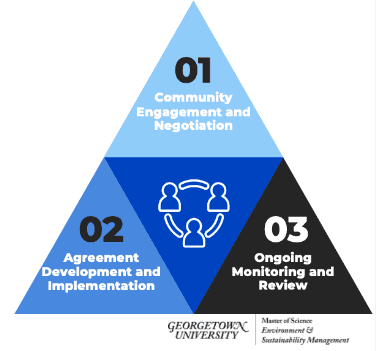Featured Posts
Mentioned
Aug 30, 2024
Resources
Sep 21, 2024
Resources
Apr 5, 2024
Oct 26, 2023
Original Authors: Maya Alcantara, Mia Astudillo, Solange Camacho, Nicolas Campos, Will Groshek, Van Murakmi, and Kelsey Naupari-Camacho
Shared with the MIT Renewable Energy Clinic by Raphael Tisch, Senior Project Analyst – U.S. Department of Energy Wind Energy Technologies Office
Summary
In the spring of 2023, a group of students in the Masters of Science in Sustainability and Environmental Management program at Georgetown University completed one of the first cataloging projects of Community Benefits Agreements (CBAs) from large-scale renewable energy projects in the United States. The project’s objectives were to 1) identify the availability, structure, and common benefits of CBAs, 2) differentiate other documents that deliver community benefits in the absence of CBAs, 3) analyze trends in CBA content and adoption, including roadblocks to usage, and 4) discuss the CBA negotiation and implementation process through a case study.
The group identified eight main stakeholder groups involved in establishing CBAs, including the Project Developer, Local Community Residents/Landowners, Local Government (Town Board, Supervisor, County Official), Community Organizations/Coalitions, Environmental Groups/Agencies, Labor Unions, Indigenous Communities, and Financing Institutions.

[image caption: The image describes the general three-step process involved in engaging these stakeholders to create the structure of a CBA.]
To thoroughly understand the role of Community Benefits Agreements (CBAs) in large-scale renewable energy projects, the Georgetown team adopted a largely qualitative research methodology. They focused on projects from 2019 onwards that had a capacity of 50 MW or greater, checking online resources for any mention of CBAs (which are often referred to by different colloquial names). This survey led to the identification of 90 projects, out of which 31 mentioned the use of CBAs.
The team also identified state-level policies that influence the adoption of CBAs. They found that California and Maine have state funding policies explicitly requiring CBAs for large-scale renewable energy projects. New York was also identified as a state with a policy that mentions CBAs, thus making it one of the three states that have recognized the importance of such agreements in their legislative frameworks.
The team used the following categories to track the nature of the CBAs in their dataset: public investing, hiring commitments, procurements, grants and donations, additional payments, continued land use, educational programs, landowner compensation, additional monitoring measures, biodiversity management, and more. The dataset can be found here. A presentation detailing the methodology and results, including a case study on the Calverton Solar Energy Center can be found here.
Background on CBAs (expandable section)
Community Benefits Agreements (CBAs) are agreements signed between community groups or coalitions and project developers, identifying the community or labor benefits a developer agrees to deliver in return for community support or workforce availability for a project[2]. CBAs are generally legally binding contracts for all parties and typically specify responsibilities, reporting, and remedies[2]. CBAs are just one type of “project agreement” used to ensure that new development projects have positive outcomes for nearby people[1]. Project agreements can be used to guarantee economic benefits such as good jobs, to reduce delays in the process, to ensure accountability, and to address environmental justice concerns[1].
CBAs emerged as a tool to ensure that new development projects have positive outcomes for nearby people[1]. The DOE now requires Community Benefits Plans as part of all BIL and IRA funding opportunity announcements (FOAs) and loan applications[2]. The Office of Minority Business and Economic Development created its Community Benefit Agreement Toolkit, which contains a comprehensive guide, frequently asked questions (FAQs), and PowerPoint presentation[3]. CBAs have been used in various renewable energy projects, such as offshore wind[4], and they offer meaningful opportunities to include voters' voices in development[5]. CBAs can change the city's development paradigm, and when decision-makers realize the advantages of projects with real benefits negotiated directly by impacted communities, the city may enact community benefits policies that set the stage for community benefit on a bigger scale[6].
Citations:
[1] https://www.wri.org/insights/community-benefits-agreements-us-clean-energy
[2] https://www.energy.gov/infrastructure/about-community-benefits-plans
[3] https://www.energy.gov/diversity/community-benefit-agreement-cba-toolkit
[4] https://legal-planet.org/2023/06/21/community-benefits-agreements-cbas-can-provide-tools-for-communities-negotiating-offshore-wind-development-impacts/
[5] https://www.dataforprogress.org/blog/2022/7/5/community-benefits-agreements-offer-meaningful-opportunities-to-include-voters-voices-in-development
[6] https://www.powerswitchaction.org/resources/community-benefits-agreements/
Takeaways
The Georgetown team's work offers valuable insights that underscore the importance of involving communities in renewable energy siting processes. There is compelling evidence to suggest that projects which prioritize fair and transparent community engagement from the outset, and that offer compensation based on stated community priorities, tend to face significantly less opposition. [See recent analysis in Stokes (2023) and Baxter (2017)].
There hasn’t been much research on tracking the processes, burdens, and benefits of these projects, so this study serves as a crucial first step. It not only analyzes the nature of CBAs but also sheds light on successful versus unsuccessful approaches, thereby providing a foundation for tracking the accountability and impacts of these agreements in the future.
The CBA database will be a valuable resource for participants in the MIT Renewable Energy Clinic in devising more equitable siting proposals for their client communities. It also opens an important window for further research in tracking the long-term impacts of these commitments.
Recommended Citation for Original Material
Alcantara, Maya, Mia Astudillo, Solange Camacho, Nicolas Campos, Will Groshek, Van Murakmi, and Kelsey Naupari-Camacho. 2023. “Community Benefits Agreements in Renewable Energy Siting.” Georgetown University.

